Artists
‘It’s a Profound Legacy’: Wendy Red Star on Carrying the Mantle of Her Ancestors
Wendy Red Star opened her most recent exhibition "Bíikkua" at Roberts Projects in Los Angeles earlier this summer.
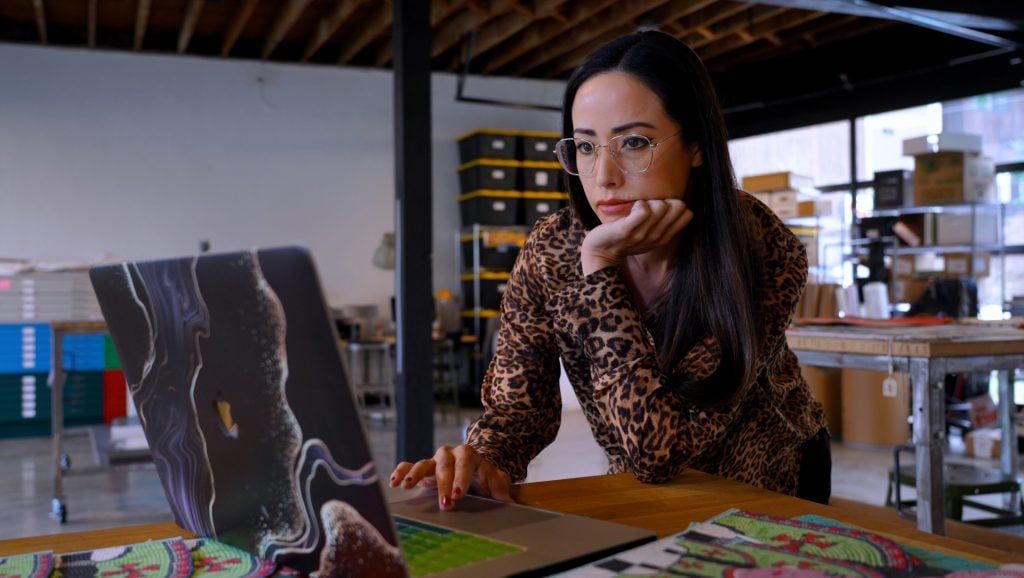
Wendy Red Star opened her most recent exhibition "Bíikkua" at Roberts Projects in Los Angeles earlier this summer.

Katie White

Wendy Red Star sees herself as one in a long matrilineal line of creators. The artist (b. 1981) grew up on the Crow Indian Reservation in Billings, Montana. During her childhood, her grandmother was always busy with a creative project—sewing, beading, or drawing. That artistic lineage dates many generations back into Red Star’s Apsáalooke ancestry. As Red Star recounts, though these women may not have described themselves as artists, they were keepers and conveyors of their tribe’s visual culture.
“I’ve named my studio after my great-great grandma, whose name was Dreams the Truth,” said the artist during a recent phone call. “It’s ‘Dreams the Truth Studios’ and it’s where I go to dream things up.”
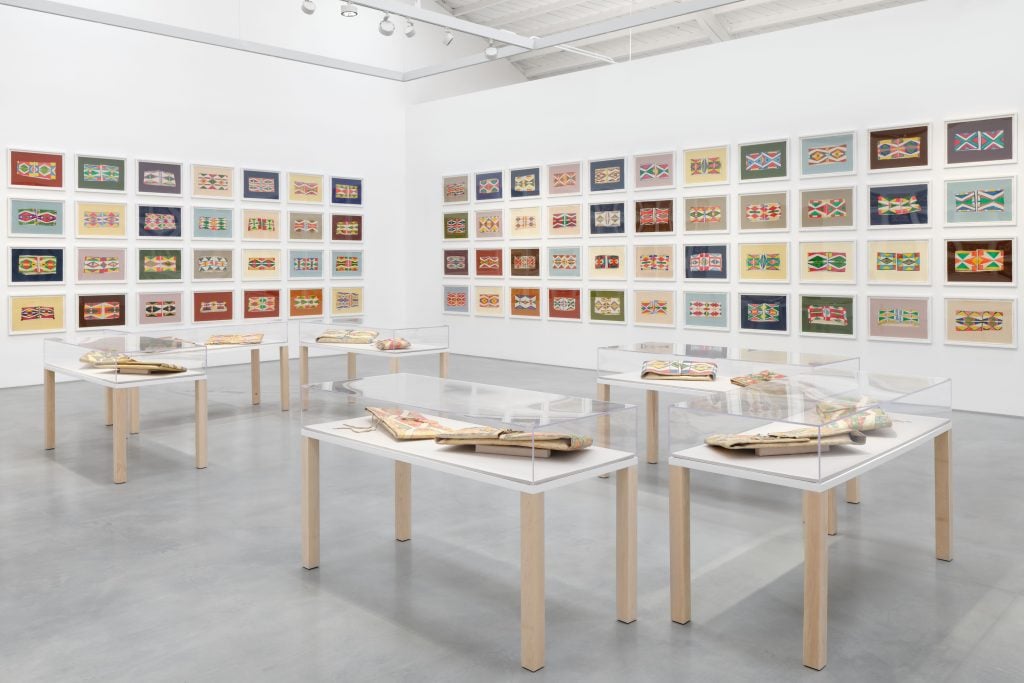
Installation view “Wendy Red: Star Bíikkua (The Hide Scraper)” 2024. Courtesy of the artist and Roberts Projects, Los Angeles, California. Photo Paul Salveson.
Red Star’s current exhibition “Bíikkua (The Hide Scraper)” at Robert Projects in Los Angeles taps into these matrilineal Indigenous traditions (through August 24). In some ways, the exhibition is an act of recovery of these women and their designs. Here, Red Star turns her attention to the bishkisché—an Apsáalooke (Crow) term for heirloom rawhide cases that were made and decorated by women. These cases were functional and used to carry belongings or food.
In both Apsáalooke and Plateau aesthetics particularly, these cases featured two painted panels with a mirrored pattern—a unique visual symbology specific to their maker, featuring brightly colorful geometric designs made with triangles, zig-zags, and rectangles.
Over the past few years, Red Star has conducted extensive research into bishkisché, compiling an archive of over a thousand images of these cases. In the exhibition, Red Star presents her painted studies of these cases along with a dozen original rawhide bishkisché from her personal collection. For Red Star, the exhibition marks a deep dive into the world of painting, a medium that has long daunted her.
“I’ve always been intimidated by painting. My background is in sculpture,” she explained “But once I started making these studies, I realized, ‘Oh my gosh, I have a whole history and ancestry of Crow women’s painting.’ It’s a profound legacy. I realized where I fit in painting.”
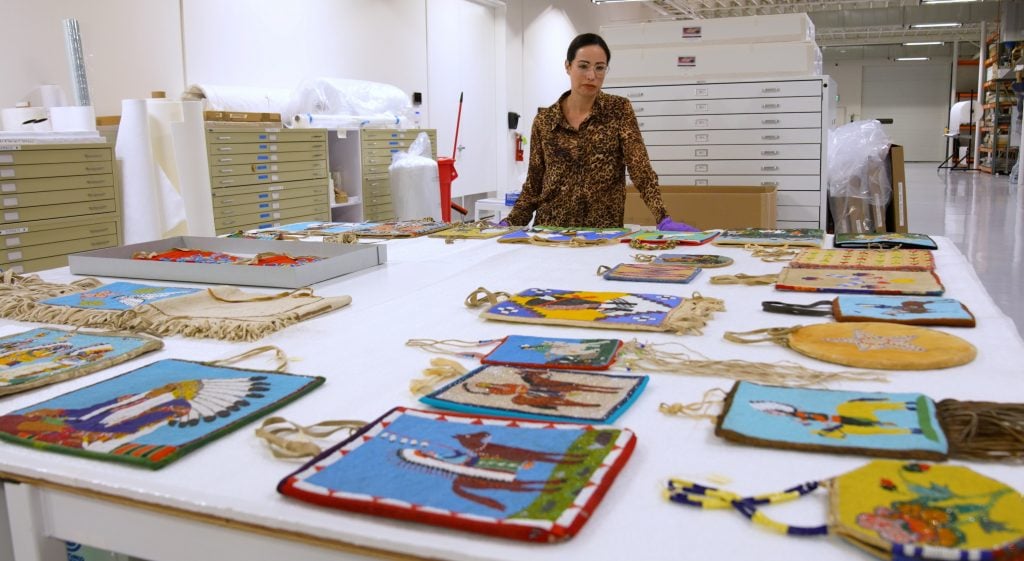
Wendy Red Star in her studio. Courtesy of Dreams The Truth Studio.
Concurrently, Red Star’s exhibition “In the Shadow of Paper Mountains” is now on view at Gathering in London (through September 1)—marking her first solo exhibition in the U.K.
Recently, we caught up with the multifaceted artist at her 2,300-square-foot studio in Portland, Oregon, where she works alongside her dog, Udon. She shared insights into the untold stories that inspire her and revealed a major upcoming exhibition for 2025.
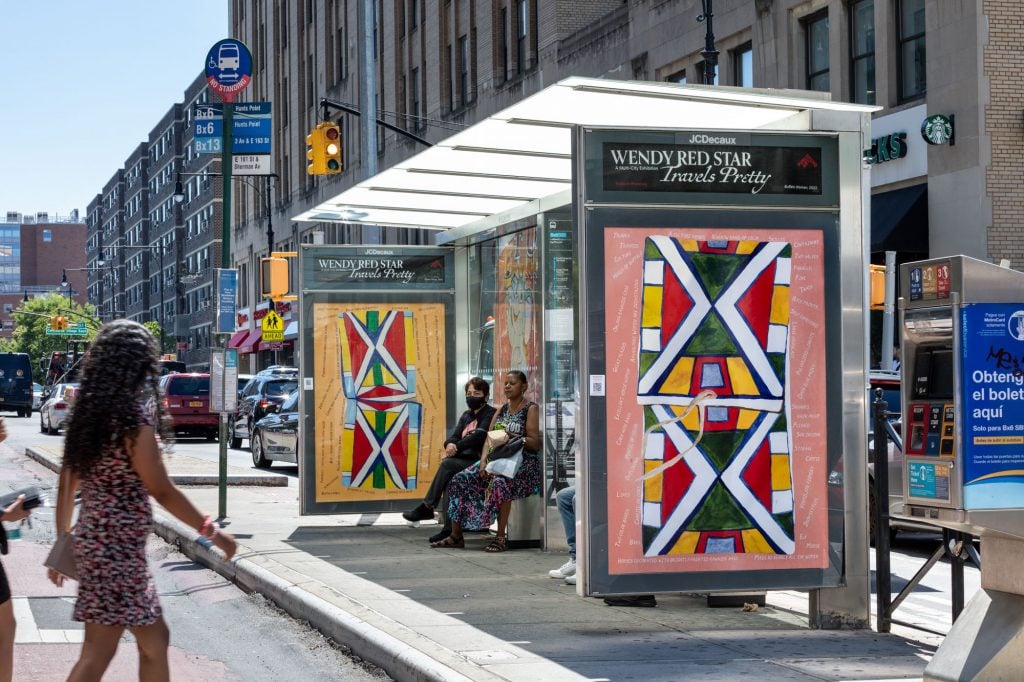
Wendy Red Star, Buffalo Woman and
Shows Going (2022).
Photo: Nicholas Knight.
Courtesy of the artist and Public Art Fund, NY.
You’ve located over a thousand images of rawhide bishkisché, from searches of auctions, catalogues, and more. This exhibition at Robert Projects includes 184 of the hundreds of studies you’ve made based on these bishkisché. Which is to say: this is a very encompassing project. Can you tell me how it began??
In 2022, I did a project for Public Art Fund which brought art to public bus shelters in New York City, Chicago, and Boston. For the project, I wanted to access major cultural institutions and see what cultural items from my community were held in these collections. Through that research, I realized that all these institutions had these rawhide cases. Bishkisché are often called parfleche which was the term used by French trappers. I’ve known about these cases forever. They’re utilitarian, but I hadn’t really given them much attention. Then I realized they were perfect for the bus shelter project since they are suitcases and meant to trade and travel. I thought it would be cool to use their patterns in the bus shelters and link them back to institutions in each city.
Through that project, I realized how important these cases are. They’re the foundation for my community and our aesthetic culture. The geometric designs on these cases are then translated into our beadwork. These cases acted like calling cards representing the entire community through the colors and the patterns.
The cases were like calling cards in what way?
The designs were meant to be visible from long distances, so that when a tribe was traveling to the next camp, another tribe could see the cases and know, hey, that’s Crow, that’s Blackfeet, and that’s Nez Pierce. I thought that was remarkable.
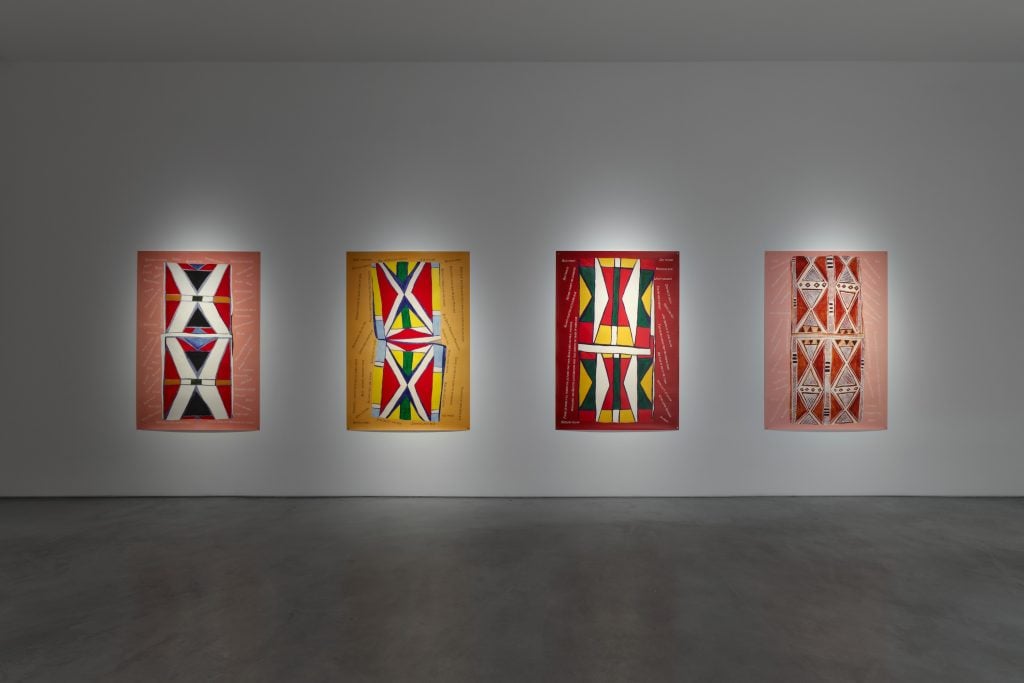
Installation view “Wendy Red Star: Bíikkua (The Hide Scraper)” 2024. Courtesy of the artist and Roberts Projects, Los Angeles, California. Photo Paul Salveson.
Women designed and painted these cases, mainly. Can you tell me about how they were made?
These were very labor-intensive. Of course, you have to hunt the animal, then the hide has to be prepared and all the hair scraped off. Then the hide is put in water and treated before you can paint it. Plus, they had to gather all the pigments from the environment. Ultimately, the hide was stretched out and staked down. These women had to paint the designs when the hide was still wet, meaning they had to paint them fairly quickly. They always made two sets, so each case has a sibling with an identical design. It’s wonderful if you can find pairs but with trading and collecting many of the pairs have been separated.
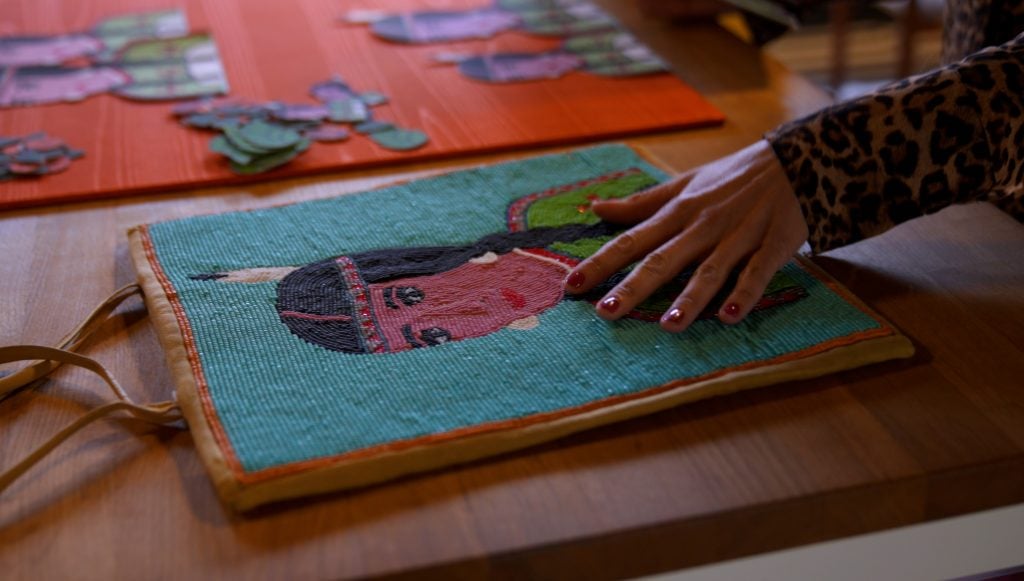
Wendy Red Star in her studio. Courtesy of Dreams The Truth Studio.
You’ve made a visual archive of these cases, keeping records when you come across them in research or online. Then you paint a study of each of them. What have you learned through that process?
Mainly I’ve been collecting images digitally from lots at auction houses, as well as eBay, and Etsy. I also look at museum collections that have been digitized. Then I make these painted studies of each one.
When I encounter these cases, they might have a tribal affiliation, but the maker’s names are almost always lost. I started thinking about names within my community. Crows just had individual names, no middle or last names. When our reservation was allotted—the land was allotted to the male heads of households. They used a Western way of naming, giving Crows Christian names and using the head of household’s name as a last name. My great-grandfather’s name was Red Star. He was head of household when the land was allotted. That’s how I have my last name. When I talk to another Crow or a Plain Feather, I know their name is connected to one of their ancestors who was a man, which is special.
But on the flip side, the women’s names never got carried on. My great-great grandmother’s Crow name translated to “Dreams the Truth.” But her dad was Bad Boy, and she was given the Christian name Julia—so Julia Bad Boy. But, underneath that, she was Dreams the Truth, such a powerful name. For this project, I decided to go into the census data for my tribe, starting in 1885 and into the 1940s, and comb through the recorded names. I collected all the female names —I’ve found over a thousand female names. I name each parfleche a female name. It’s a way to carry on that name and the anonymous makers of these cases.
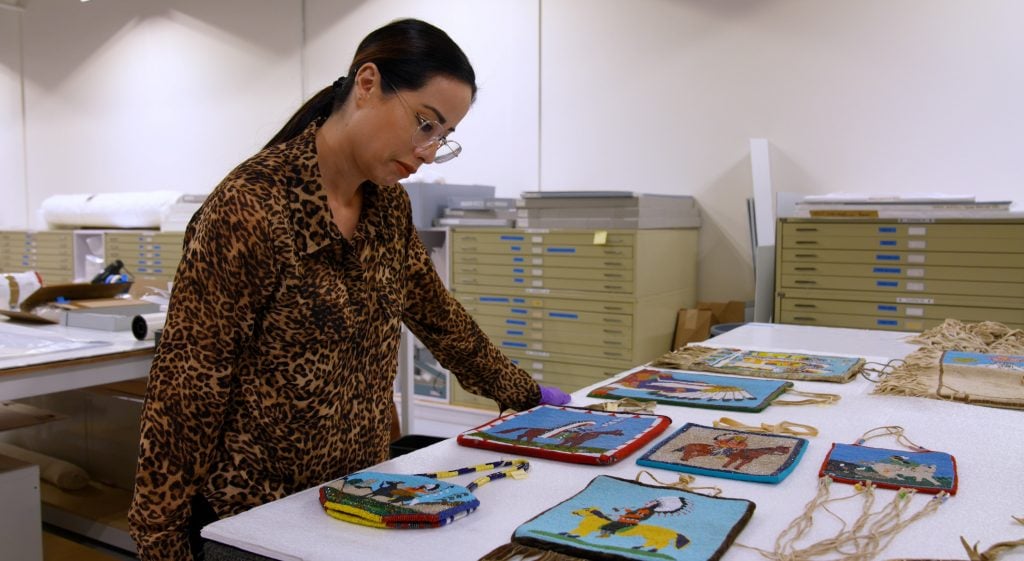
Wendy Red Star in her studio. Courtesy of Dreams The Truth Studio.
You have a very diverse practice. You’ve worked in installation, painting, sculpture, and photography. What drives this omnivorous approach to art-making?
I’m 43 now and I’ve had time to think about this. Growing up, I struggled with dyslexia. It was a huge challenge for me to learn conventionally. When I started focusing on art, I realized that’s how I actually learn. If I want to learn about something, in order for the information to sink in, I need to make a visual representation of what I’m learning about. The cool thing about art is that I’m constantly learning, so it’s highly addictive. I’m also producing artworks that other people can learn from too. I use so many mediums because I choose whatever best represents this information most strongly.
Along with the show at Roberts Projects, you also have your first solo exhibition in the U.K. on view right now, “In the Shadow of Paper Mountains” at Gathering. This show includes an installation of the Pryor Mountains, based on a vintage pop-up greeting card. What were you thinking about with this show?
This is my first solo exhibition in the U.K. There’s a different history with native people and not the same knowledge, but I think there can be a sense of freedom in that as well.
I started thinking about trading between Europe and the U.S. Early trading shaped what the United States became, and that ricocheted back across the pond. Everything in the U.S. is thought about as a resource. The Pryor Mountains are where I grew up, but that land was a huge resource and commodity and a big draw. At the same time, I am fascinated by the European romanticization of the West. It becomes a fictional landscape. This postcard landscape is at once a romanticized vision of the West, while simultaneously something very real to me.
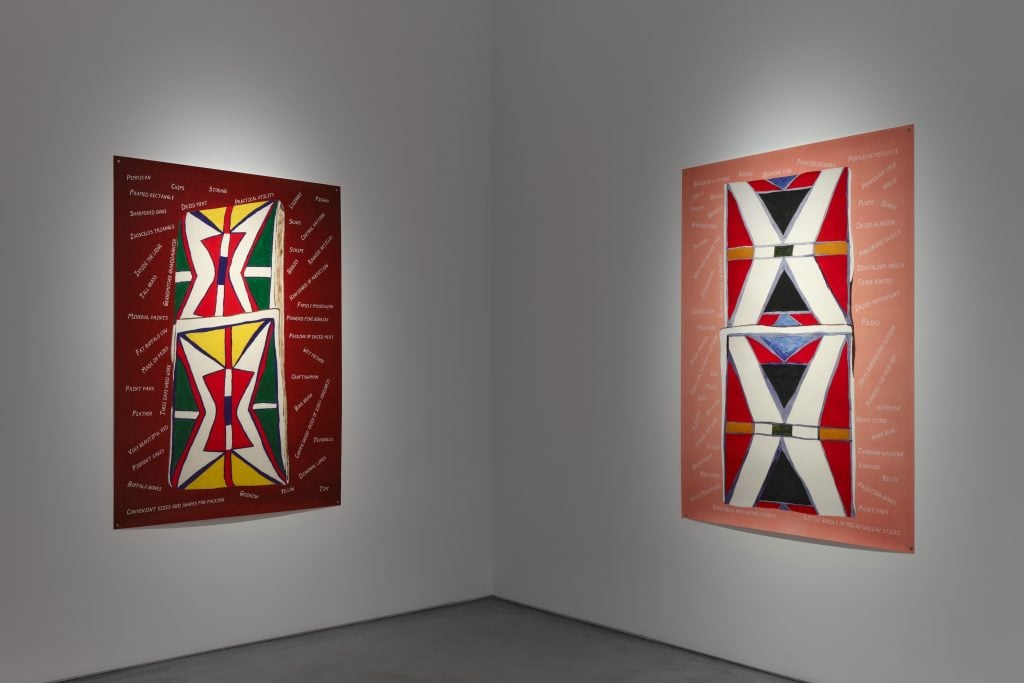
Installation view “Wendy Red: Star Bíikkua (The Hide Scraper)” 2024. Courtesy of the artist and Roberts Projects, Los Angeles, California. Photo Paul Salveson.
What’s on the horizon for you next?
I will have a solo exhibition at the National Portrait Gallery opening in 2026. The show is going to focus on the Crow tribe chief Plenty Coups, who was the last chief elected a chief by other chiefs.
Soon I’ll be going to Chief Plenty Coups State Park in Montana, When he died he gave land to become a state park which is one of the only state parks within a reservation.. They have a visitor center with a lot of his personal items, his log cabin, and he’s buried there.
Chief Plenty Coups had a really rich connection with Washington D.C. He traveled there for the first time in 1880 and was enamored with Washington’s estate Mount Vernon. That visit was the seed of the idea for turning his land into a state park—a place where, you know, people could come and feel invited and learn about Crow culture.
He traveled to D.C. at least 11 times. In the 1920s, he also represented all Native Americans during the dedication of the tomb of the unknown soldier. The National Portrait Gallery was once the Bureau of Indian Affairs, which means the Chief was once in the building where this exhibition will be held. It’s been such an amazing research project already.